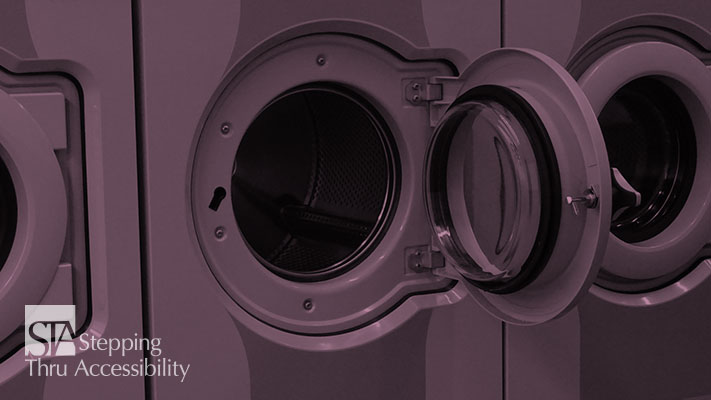Blog
Return to Blog »
Janis Kent, FAIA Architect, CASp © July, 2017; rev October 2021 This is a relatively simple topic, but I have seen a number of new facilities where these are not specified or installed in a compliant fashion. The ADA standards does not require all of the machines to be accessible. In each accessible space, one minimum is required to be accessible for a dryer and one for a washing machine. And if there are more than 3 washers or 3 dryers, then two are required to be accessible of each. This is applicable whether it is in a laundromat, or a common space laundry room for public residential dwelling units, or student housing at a place of education, or social service center establishment sleeping rooms, or a mobility feature dwelling unit. There are several items we need to be concerned with for making these appliances accessible. Each accessible machine is required to have its own clear floor space set up for parallel approach. The clear floor space centerline aligns with the centerline of the machine. Generally this would be a 30″ x 48″ level space, but if the space is obstructed for more than half its depth or width it would increase to 36″ x 48″ or 30″ x 60″ depending on which side of the clear floor space is obstructed. The controls are to be accessible which means they are to be within reach range and are operable with one hand without tight grasping, pinching, or twisting of the wrist with 5 lbs maximum operating force. This would include coin slots, all settings and controls, soap dispenser covers, and lint covers if provided. Generally the controls will need to be placed on the front of the machines for most models. If the machines are front loading, then the bottom of the opening itself is to be located within 15″ to 36″ AFF. The door hardware should be 48″ maximum AFF and preferably measured to the top of the operable part. There is no requirement for the bottom of the drum itself – just the opening. If the machines are top loading, per ADA, the top of the door in the closed position is allowed to be 36″ maximum AFF – but be aware of reach ranges for controls, since one can not do a side reach over an obstructing object greater than 34″ AFF – controls would need to be placed on the front surface. There is some thought, though, since top-loading machines are allowed to be 36″ maximum in height, a side reach is acceptable over the 36″ height of the machine so the controls can be placed towards the back. But be aware of reach depth if greater than 10″, the controls would then need to be 46″ maximum to the top and 24″ maximum in depth. If the machines are located in a closet, then the closet opening should be wide enough to have a clear floor space centered on each machine without being obstructed by the door casing or the door itself. Another item to note. If the project has HUD funds, be aware, washers and dryers are one of the 11 exceptions that HUD does not feel is equivalent in the ADA. So each washer and dryer is required to be an accessible front loading machine. In laundry rooms, if there are counters, a portion of each type of counter needs to be accessible. If there is a service sink, be sure to provide a parallel approach. And if there are vending machines for soap, then one of each type is required to be on an accessible route with a clear floor space in front, with the controls within reach range, and operable with one hand without tight grasping, pinching, or twisting of the wrist and 5 lbs maximum of operating force. While these requirements do not appear to be complex at first glance, keep in mind the parameters for specifications of the appliance itself. And do remember the clear floor space is parallel and centered so this needs to be planned for ahead since many closet configurations do not provide enough space. And if there are HUD funds, at this point in time, all washers and dryers are required to be accessible rather than just a proportion which is the requirement under ADA. Be aware that your local City or County may have additional requirements that are more restrictive than the State or Federal requirements. Also, this article is an interpretation and opinion of the writer. It is meant as a summary – current original regulations should always be reviewed when making any decisions. © Janis Kent, Architect, FAIA, CASp July, 2017Washers & Dryers, and Access
